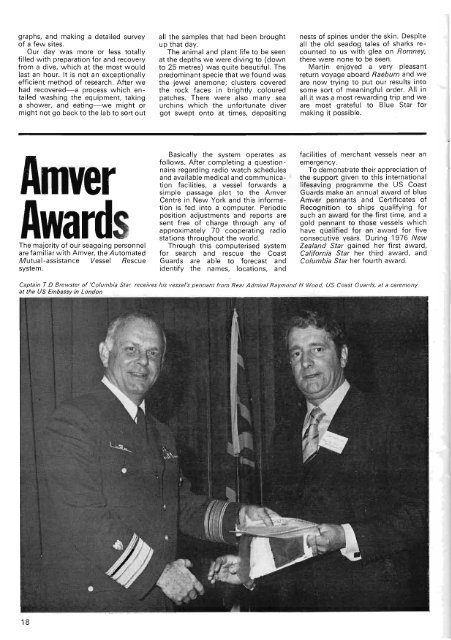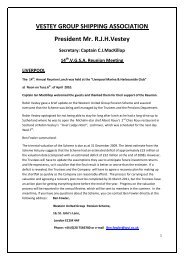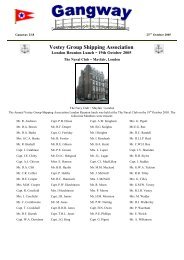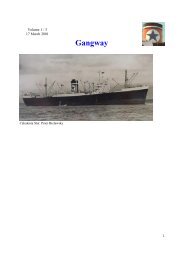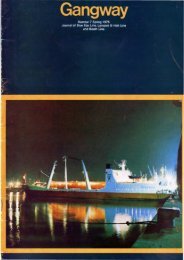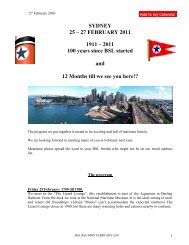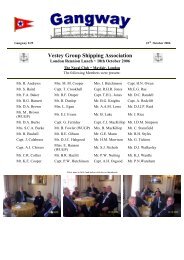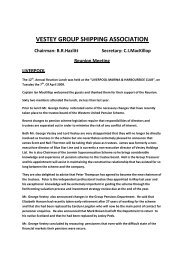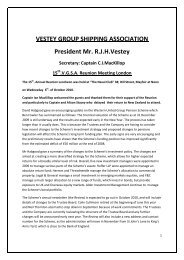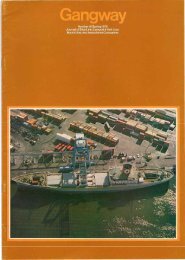Blue Star Gangway No.15 Spring 1978 - BlueStarLine.org
Blue Star Gangway No.15 Spring 1978 - BlueStarLine.org
Blue Star Gangway No.15 Spring 1978 - BlueStarLine.org
You also want an ePaper? Increase the reach of your titles
YUMPU automatically turns print PDFs into web optimized ePapers that Google loves.
graphs, and making a detailed survey<br />
of a few sites.<br />
Our day was more or less totally<br />
filled with preparation for and recovery<br />
from a dive, which at the most would<br />
last an hour. It is not an exceptionally<br />
efficient method of research. After we<br />
had recovered-a process which entailed<br />
washing the equipment, taking<br />
a shower, and eating-we might or<br />
might not go back to the lab to sort out<br />
all the samples that had been brought<br />
up that day.<br />
The animal and plant life to be seen<br />
at the depths we were diving to (down<br />
to 25 metres) was quite beautiful. The<br />
predominant specie that we found was<br />
the jewel anemone; clusters covered<br />
the rock faces in brightly coloured<br />
patches. There were also many sea<br />
urchins which the unfortunate diver<br />
got swept onto at times, depositing<br />
nests of spines under the skin. Despite<br />
all the old seadoq tales of sharks recounted<br />
to us with glea on Romney,<br />
there were none to be seen.<br />
Martin enjoyed a very pleasant<br />
return voyage aboard Raeburn and we<br />
are now trying to put our results into<br />
some sort of meaningful order. All in<br />
all it was a most rewarding trip and we<br />
are most grateful to <strong>Blue</strong> <strong>Star</strong> for<br />
making it possible.<br />
Amver<br />
Award<br />
The majority of our seagoing personnel<br />
arefamiliar with Amver, the Automated<br />
Mutual-assistance Vessel Rescue<br />
system.<br />
Basically the system operates as<br />
follows. After completing a questionnaire<br />
regarding radio watch schedules<br />
and available medical and communication<br />
facilities, a vessel forwards a<br />
simple passage plot to the Amver<br />
Centre in New York and this information<br />
is fed into a computer. Periodic<br />
position adjustments and reports are<br />
sent free of charge through any of<br />
approximately 70 cooperating radio<br />
stations throughout the world.<br />
Through this computerised system<br />
for search and rescue the Coast<br />
Guards are able to forecast and<br />
identify the names, locations, and<br />
facilities of merchant vessels near an<br />
emergency.<br />
To demonstrate their appreciation of<br />
the support given to this international<br />
lifesaving programme the US Coast<br />
Guards make an annual award of blue<br />
Amver pennants and Certificates of<br />
Recognition to ships qualifying for<br />
such an award for the first time, and a<br />
gold pennant to those vessels which<br />
have qualified for an award for five<br />
consecutive years. During 1976 New<br />
Zealand <strong>Star</strong> gained her first award,<br />
California <strong>Star</strong> her third award, and<br />
Columbia <strong>Star</strong> her fourth award.<br />
Captain T D Brewster of 'Columbia <strong>Star</strong> receives his vessel's pennant from Rear Admiral Raymond H Wood, US Coast Guerds, at a ceremony<br />
at the US Embassy in London<br />
18


